Imagine stepping onto your 15 acre homestead, where the air is filled with the sweet aroma of flowers, each petal not only a feast for the eyes but also for the palate. This is the enchanting world of edible flowers on your homestead, a concept that blends beauty with sustainability. As you embark on this journey, you’ll find that growing edible flowers enriches your landscape and enhances your culinary experiences.
In this article, we explore how you can integrate edible flowers into your 15 acre homestead, transforming it into a thriving, vibrant ecosystem. From the delicate petals of pansies to the spicy zing of nasturtiums, each bloom offers unique flavors and health benefits that can elevate your homestead living.

The Charm of Edible Flowers
Edible flowers are not just for gourmet chefs or upscale dining. They are a delightful addition to any homestead, providing both visual appeal and nutritional value. Beyond aesthetics, these blooms can play a crucial role in sustainable living, offering a natural and organic way to enhance your meals.
Why Grow Edible Flowers?
Growing edible flowers on your homestead is a form of sustainable living. They attract pollinators, improve biodiversity, and can be grown alongside your vegetables and herbs. This practice not only beautifies your garden but also supports an eco-friendly lifestyle.
Choosing Edible Flowers for Your Homestead
When selecting edible flowers, consider your climate, soil type, and personal taste preferences. Some popular choices include:
- Nasturtiums: Known for their peppery flavor, they are great in salads.
- Pansies: These offer a mild, grassy taste and are perfect for garnishing cakes.
- Calendula: Often called ‘poor man’s saffron’, they add a golden hue to dishes.
Each of these flowers brings unique flavors and textures, making them versatile additions to any dish.
Companion Planting with Edible Flowers
Integrating edible flowers into your vegetable garden as companion plants can enhance growth and deter pests. For example, marigolds are known to repel nematodes, while borage can attract beneficial insects.
Growing and Caring for Edible Flowers
Caring for edible flowers is similar to tending other garden plants. Ensure they have well-drained soil, adequate sunlight, and regular watering. Organic fertilizers and natural pest control methods will help maintain a healthy garden while keeping your flowers safe for consumption.
Harvesting Edible Flowers
Harvesting should be done in the morning when the blooms are freshest. Gently wash them to remove dirt and insects. Use the flowers immediately or store them in the refrigerator for a few days.
Incorporating Edible Flowers into Your Diet
There are countless ways to use edible flowers in your culinary creations. They can be tossed in salads, used to flavor desserts, or even infused into beverages. The key is experimentation and enjoying the fusion of flavors these flowers provide.
Edible Flower Recipes
Here are a few simple recipes to get you started:
- Flower Infused Vinegar: Add a handful of lavender or rose petals to a bottle of vinegar for a fragrant twist.
- Herb and Flower Butter: Mix softened butter with chive blossoms and thyme for a delicious spread.
- Sugared Pansies: Coat pansies in sugar for a sweet, edible decoration.
The Health Benefits of Edible Flowers
Beyond their culinary uses, edible flowers offer health benefits. Many are rich in antioxidants and vitamins. For example, hibiscus is known for its vitamin C content, while dandelion flowers can aid digestion.
Edible Flowers and Holistic Wellness
Incorporating edible flowers into your diet can promote holistic wellness. They are a natural way to enhance your diet, offering both nutritional value and therapeutic properties.
Sustainability and Edible Flowers on the Homestead
Growing edible flowers contributes to sustainability on your homestead. They require minimal resources, improve biodiversity, and reduce reliance on store-bought produce. By cultivating these flowers, you are taking a step towards a more self-sufficient and eco-friendly lifestyle.
Integrating Edible Flowers with Other Sustainable Practices
Consider pairing your edible flower garden with other sustainable practices. For instance, rainwater harvesting can provide the necessary irrigation, while composting can enrich the soil.
Conclusion: A Blooming Future with Edible Flowers
Embracing edible flowers on your 15 acre homestead opens up a world of possibilities. It combines the joys of gardening with the pleasures of cooking, all while promoting a sustainable lifestyle. As you cultivate these vibrant blooms, you’ll find that the benefits extend beyond the garden, enriching your life in unexpected ways.

FAQs About Edible Flowers on the Homestead
Are all flowers safe to eat?
Not all flowers are edible. It’s essential to research and ensure the flowers you choose are safe for consumption. Avoid flowers that have been treated with pesticides unless they are specifically labeled for consumption.
How can I tell if a flower is edible?
Consult a reputable guide or expert on edible flowers. When in doubt, it’s better to err on the side of caution and avoid consuming unknown flowers.
What are some common edible flowers?
Common edible flowers include nasturtiums, violets, dandelions, and marigolds. Each offers distinct flavors and can be used in various culinary applications.





